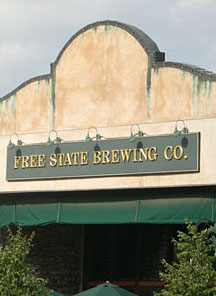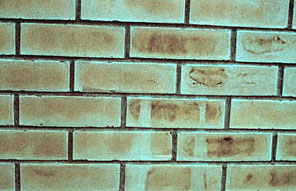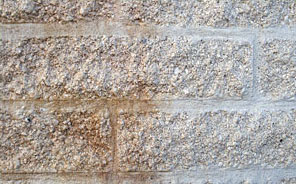When Metal Bleeds
By Gary Henry
 Water impregnated with copper particles has run off the copper sheathing atop this restaurant, penetrating the concrete stucco below and leaving ugly green stains. |
When a metal bleeds on masonry, the result is called metallic staining. The stains are just as ugly as they sound. And like stains from other kinds of bleeding, metallic staining is hard to remove.
Orange Stains at St. Andrew's Cathedral
About 30 years ago, workers installed metal grates on the windows of St. Andrews Cathedral in Grand Rapids, Mich. During recent restoration work, conservators discovered the stains. Three decades of water running off the metal onto the historic brick - a buff yellow from the 1800s - left deeply embedded orange stains in the wall around the windows.
Doug Barron, an industry consultant with Seals Inc., in Bridgeport, successfully tested a specialty liquid cleaner for metallic staining on the rusty brick. The cleaner, Sure Klean® Ferrous Stain Remover, works by re-dissolving the iron oxides that caused the stain so that they can be flushed away with a fresh-water rinse.
"We got the stains out 80 to 85%," Barron recalls. "The clients were very happy. They didn't want their historic building to look totally new anyway."
Green Stains on Wacker Drive
During the reconstruction of Chicago's Wacker Drive in 2003 and 2004, workers faced deep, penetrating copper staining on porous Indiana limestone.
"They were bright green streaks, almost kelly green on the gray stone," says Jim Lucas, a consultant and masonry expert with Lucas & Associates in Hammond, Ind. "They varied in length from a few inches to six feet."
The stains occurred on the south side of the split-level thoroughfare, where bridges spanning the Chicago River met the drive. Since 1924, rain, sleet, snow and ice washed over bronze commemorative plaques, planters and light fixtures. Decade after decade, the copper-impregnated water ran off the bronze and soaked into the stone.
 Post-construction clean down with muriatic acid dissolved and "mobilized" the metallic salt vanadium in these light-colored bricks, resulting in wide-spread metallic staining. |
Poultice cleaners go on stained substrates in paste form. In this case, workers created the paste by mixing a powerful cleaning agent packaged together with a compatible clay powder. They covered the paste with plastic and fastened it down with duct tape. As the poultice dried overnight, it pulled the contaminants out of the substrate. When the dried poultice was removed, it also removed contaminants from the masonry pores.
Lucas reports that by using the poultice method, workers removed about 95 to 98% of the green metallic staining from the limestone.
Brown Stains in Kansas
Metallic staining doesn't always come from water running off metal.
Mike Dickey, a partner in the manufacturer's representative firm Frieze and Associates in Leawood, Kan., reports that a middle school in Gardner where the contractor tried to cut corners paid the price with stains. The contractor used cheap muriatic acid, also referred to as hydrochloric acid, for post-construction clean down rather than the proprietary new construction cleaner specified by the architect.
The result, Dickey says, was a huge brown stain that spread across the north face of the school's gymnasium. "It looked like a rash on the brick," he says. "It was nasty."
Many brick manufacturers use metallic additives, such as manganese, to create various brick colors and effects. In this case, the muriatic acid reacted directly with the metallic content to create hard-to-remove stains.
Although proprietary masonry cleaners may contain acid, it's usually in small amounts. The acid component is harnessed and channeled by inhibitors, surfactants and other ingredients that magnify the acid's useful properties while keeping the masonry safe. These cleaners also come with specific application and safety instructions - something muriatic acid doesn't.
Dickey successfully tested a proprietary blend of acid, surfactants (the main component of detergents) and inhibitors on the disfigured masonry. The solution re-dissolved the metallic stains for rinsing away with clean water. Using the specialty product, workers restored the wall to its intended appearance.
Rust Stains at Merrill Lynch
 Rust stains can be removed, sometimes with up to 100 percent effectiveness. The key is using proprietary cleaners made for that purpose. Here, a contrast is shown between uncleaned (left) and cleaned sections of a concrete brick wall. |
The Detroit water supply is high in iron, explains Barron of Seals Inc. After about 10 years of sprinkler water splashing on the light-red brick walls, orange stains were visible where the water was deposited. Workers took the rust off the brick without harm, again using a proprietary liquid cleaner made for the purpose.
Unless the condition that caused the staining is corrected, in most cases the metallic staining will simply reoccur. The answer to this maintenance issue, Barron says, is the use of a breathable, penetrating water repellent. Today's most advanced silicone-based water repellents can keep water and the problems it causes out of every kind of masonry.
There are many different kinds of water repellents. They can enhance substrate appearance or leave it unchanged. The bottom line is that water can't deposit stains in masonry if it can't get into the masonry to begin with.
The discussion of water repellants is the topic of a whole different article, though.
For a free copy of PROSOCO's guide to common brick staining, call toll-free (800) 255-4255, or e-mail customer care@prosoco.com.
About the Author
Gary Henry is a business communication specialist with PROSOCO, a national manufacturer of products for cleaning, protecting and maintaining masonry, concrete and stone. For more information, contact Gary Henry at 785-830-7343, or e-mail ghenry@prosoco.com.


















